
Return to the famous Sagrada Familia cathedral in Sagrada: Passion, the first of the three Great Facades expansions. This modular expansion revels in artistic freedom-add everything inside or handpick individual components to enhance your crafting experience.
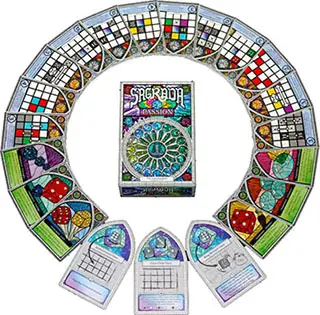
Components
- 6 Rare Glass Boards
- 6 Inspiration Cards
- 6 Rare Glass Dice
- 7 Private Objects
- 6 Public Objects
- Instructions
What's New
Inspiration Cards - special abilities that give each player a unique advantage
Rare Glass Dice - unique dice that represent any color when placed in a window
Rare Glass Boards - unique ways to obtain Rare Glass Dice; one board replaces a tool card and costs favor tokens to use
Rare Glass Private Objectives - objectives that are used along with Rare Glass Dice & Boards to create new scoring opportunities
Symmetry & Balance Public Objectives - objectives that reward players for creating symmetry and balance in their window
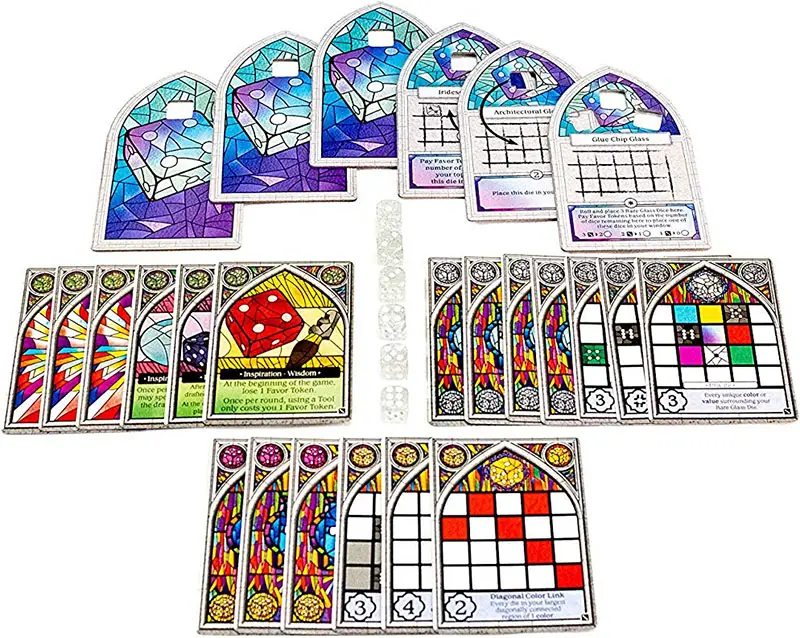
Inspiration Module
This module introduces Inspiration Cards, which provide special abilities that give each player a unique advantage.
Player Setup
Before selecting a Window Pattern Card:
- Shuffle all Inspiration Cards together.
- Give 1 Inspiration Card to each player.
- Have each player reveal their Inspiration Card, placing it face-up near their player board.
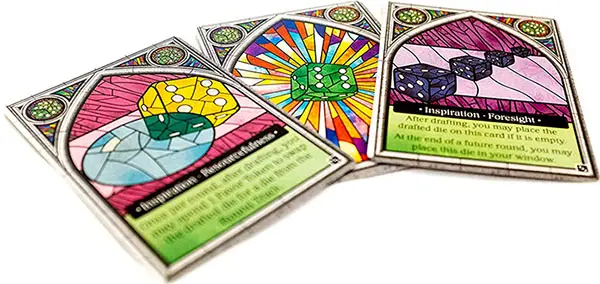
Inspiration Abilities
Unless otherwise indicated, Inspiration Abilities may be used any time during a player's turn.
Some Inspiration Cards may only be used once per round or once per game. After using an Inspiration Ability, flip the card over (face-down) to indicate that it was used. Turn any "once per round" Inspiration Cards face-up at the beginning of the next round.
Rare Glass Module
This module introduces new dice that represent rare types of stained glass that can be placed in a player's window next to any color die.
Rare Glass Boards allow players to acquire and place Rare Glass Dice in their windows. These dice pair with new Private Objectives offering new ways to score.
Setup
Before selecting Tool Cards:
- Randomly select 1 Rare Glass Board. Place it face-up in the middle of the play area.
- Roll 1 Rare Glass Die for each slot in the Rare Glass Board and place it in a slot.
- Only reveal 2 Tool Cards instead of 3.
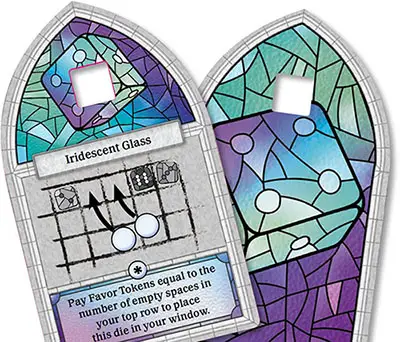
Player Turns
As an action, a player may pay Favor Tokens to use a Rare Glass Board, taking a Rare Glass Die from it to place in their window. Unless otherwise indicated, this may be done at any time during their turn.
A player may only have 1 Rare Glass Die in their window. If a player already has a Rare Glass Die in their window, they may not use a Rare Glass Board.
If during the round there are no Rare Glass Dice on the Rare Glass Board, roll a new Rare Glass Die for each slot on the board and place it in a slot.
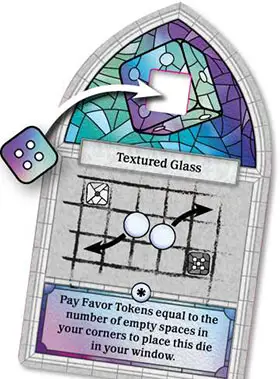
Rare Glass Dice
Rare Glass Dice have several unique properties that make them slightly different than standard dice:
These dice are not considered to be any color, so they never break color adjacency restrictions. Shade (value) adjacency restrictions still apply as normal.
These dice may be placed over any color restriction on a Window Pattern Card, but they must still obey shade (value) restrictions.
A space holding a Rare Glass Die is not considered empty. It will count toward completing its row, column, or diagonal.
These dice contribute to Row / Column Color Variety as if they were a unique color (i.e., a row completed with a Rare Glass Die - and otherwise filled with 4 uniquely colored dice - is considered to have no repeats and would count when scoring Row Color; Variety).
Rare Glass Private Objectives
These Private Objectives give scoring opportunities based on the configuration of a Rare Glass i Die and the dice around it in a player's window. These are only used when using the Rare Glass module.
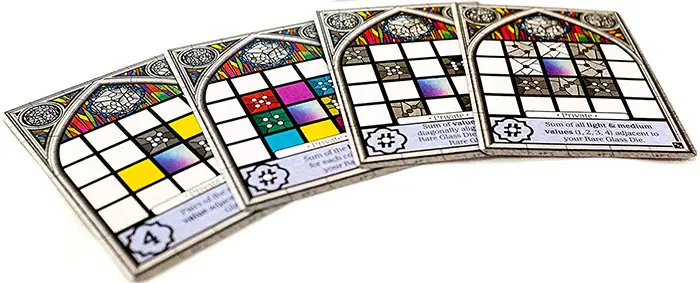
Player Setup
Shuffle all Rare Glass Private Objectives (as indicated by the Rare Glass Die on the back). These are used instead of any other Private Objective.
Give 1 to each player, face-down. Players may secretly look at their Private Objective.
Score these as normal at the end of the game.
Symmetry Public Objectives
These objectives can be mixed in with other Public Objectives when randomizing game setup.
Scoring for these is similar to the base game private objectives.
Recommendation:
Some of these new objectives score under conditions that are at odds with objectives from the base game. We recommend avoiding combinations like Vertical Color Balance and Column Color Variety, Horizontal Shade Symmetry and Row Shade Variety, etc. '
Continue Reading


